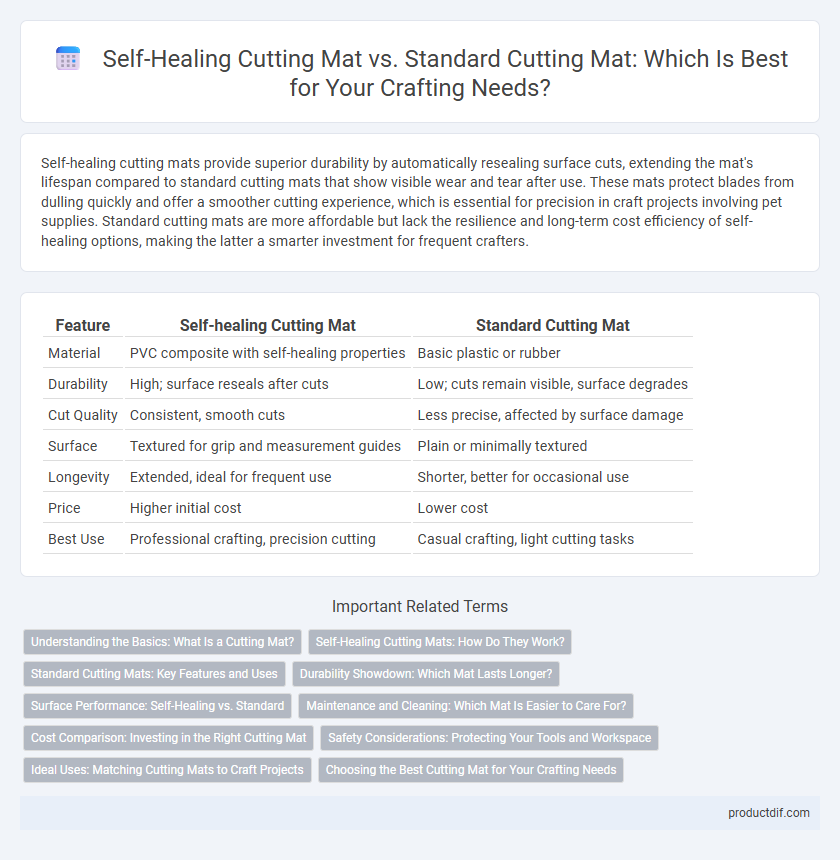Self-healing cutting mats provide superior durability by automatically resealing surface cuts, extending the mat's lifespan compared to standard cutting mats that show visible wear and tear after use. These mats protect blades from dulling quickly and offer a smoother cutting experience, which is essential for precision in craft projects involving pet supplies. Standard cutting mats are more affordable but lack the resilience and long-term cost efficiency of self-healing options, making the latter a smarter investment for frequent crafters.
Table of Comparison
| Feature | Self-healing Cutting Mat | Standard Cutting Mat |
|---|---|---|
| Material | PVC composite with self-healing properties | Basic plastic or rubber |
| Durability | High; surface reseals after cuts | Low; cuts remain visible, surface degrades |
| Cut Quality | Consistent, smooth cuts | Less precise, affected by surface damage |
| Surface | Textured for grip and measurement guides | Plain or minimally textured |
| Longevity | Extended, ideal for frequent use | Shorter, better for occasional use |
| Price | Higher initial cost | Lower cost |
| Best Use | Professional crafting, precision cutting | Casual crafting, light cutting tasks |
Understanding the Basics: What Is a Cutting Mat?
A cutting mat is an essential tool for craft enthusiasts, designed to protect work surfaces and preserve blade sharpness while cutting materials. Self-healing cutting mats feature a unique surface that reseals after each cut, ensuring a smooth and durable workspace, unlike standard cutting mats that show permanent marks and wear quickly. Understanding the difference in functionality and durability is crucial for selecting the right cutting mat to enhance precision and longevity in crafting projects.
Self-Healing Cutting Mats: How Do They Work?
Self-healing cutting mats consist of multiple layers of resilient PVC that close up after a blade cuts into the surface, maintaining a smooth, damage-free workspace ideal for precision crafts. These mats preserve blade sharpness by minimizing contact with the cutting edge, unlike standard cutting mats that accumulate grooves and cuts over time. Their self-repairing properties extend the mat's lifespan and ensure consistent cutting performance for quilting, sewing, and paper crafting projects.
Standard Cutting Mats: Key Features and Uses
Standard cutting mats feature a durable single-layer surface designed to protect workspaces from sharp blades while providing a stable cutting area. They are typically made from PVC or similar materials, offering a cost-effective solution suitable for light to moderate craft projects. Commonly used for paper cutting, fabric trimming, and scrapbooking, these mats do not have self-healing properties and may show visible cut marks over time.
Durability Showdown: Which Mat Lasts Longer?
Self-healing cutting mats are engineered with multiple layers of PVC that close up after each cut, significantly extending their lifespan compared to standard cutting mats that easily show permanent marks and wear. The durable surface of self-healing mats ensures consistent smoothness and protects blades, making them ideal for frequent, heavy-duty crafting projects. Standard cutting mats, typically made from thinner materials, degrade faster under repetitive use, leading to a shorter lifespan and less reliable cutting performance.
Surface Performance: Self-Healing vs. Standard
Self-healing cutting mats feature a resilient surface composed of multiple layers that absorb cuts and reseal quickly, maintaining a smooth, consistent cutting area ideal for precision crafting. Standard cutting mats, typically made from a single layer of vinyl or PVC, show permanent grooves and damage over time, which can affect blade accuracy and fabric integrity. The superior surface performance of self-healing mats significantly extends usability and protects cutting tools compared to standard mats.
Maintenance and Cleaning: Which Mat Is Easier to Care For?
Self-healing cutting mats, made from durable PVC layers, resist deep cuts and require minimal cleaning, often needing only a wipe with a damp cloth to maintain their surface integrity. Standard cutting mats, typically thinner and made from less resilient materials, accumulate residue and cuts more easily, demanding frequent cleaning and occasional replacement to ensure smooth cutting surfaces. The self-healing mat's advanced material composition offers superior ease of maintenance compared to standard mats, extending usability and reducing upkeep efforts.
Cost Comparison: Investing in the Right Cutting Mat
Self-healing cutting mats typically cost more upfront than standard cutting mats but offer longer durability, reducing replacement frequency and overall expenses. Standard cutting mats have lower initial prices but tend to wear out quickly, leading to higher long-term costs due to more frequent purchases. Evaluating the balance between initial investment and mat longevity helps crafters select the most cost-effective cutting mat for their projects.
Safety Considerations: Protecting Your Tools and Workspace
Self-healing cutting mats provide superior protection for blades by reducing dulling and preventing nicks, extending tool longevity compared to standard cutting mats. Their resilient surface absorbs cuts without permanent damage, safeguarding your workspace from scratches and gouges. Investing in self-healing mats enhances both safety and efficiency, minimizing accidental slips that can occur on harder, less forgiving standard mats.
Ideal Uses: Matching Cutting Mats to Craft Projects
Self-healing cutting mats are ideal for frequent use in quilting, sewing, and precision cutting, as they maintain a smooth surface by resealing after cuts, reducing blade dulling and material damage. Standard cutting mats work well for occasional crafting or paper cutting, offering a more affordable option but wearing out faster and showing visible cut marks. Choosing the right cutting mat depends on the craft project's intensity and the need for durability and surface longevity.
Choosing the Best Cutting Mat for Your Crafting Needs
Self-healing cutting mats are designed with a resilient surface that reseals after each cut, prolonging their lifespan and maintaining a smooth work area, making them ideal for frequent crafters and precision projects. Standard cutting mats offer a budget-friendly option but tend to show cut marks more quickly, which can affect the accuracy of future cuts. Selecting the best cutting mat depends on balancing durability, cost, and the specific demands of your crafting tasks to ensure efficient and accurate cutting performance.
Self-healing Cutting Mat vs Standard Cutting Mat Infographic

 productdif.com
productdif.com